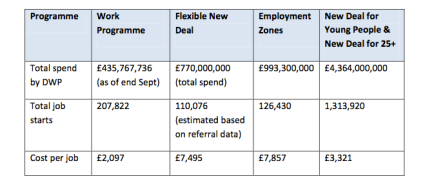 Jane Mansour argues that budget cuts are made without sufficient acknowledgement of whether and how such actions will drive up costs in future years or in other areas of government. It would be better to examine the current austerity strategy through the frames of value, investment and planning for future needs.
Jane Mansour argues that budget cuts are made without sufficient acknowledgement of whether and how such actions will drive up costs in future years or in other areas of government. It would be better to examine the current austerity strategy through the frames of value, investment and planning for future needs.
Chris Grayling has described many of his reforms in both employment and justice as “delivering value for money for the taxpayer”. It is difficult, however, to find evidence of the consideration of ‘value’ in recent and planned changes. Instead, as discussions about public services become increasingly polarised, cost and value are conflated. The nuance of what those terms mean and how they are measured is lost. The efficiency of a service is presented in terms of cost, and understanding often limited to the direct cost of providing that service.
Cost versus value is not a linguistic aside, it is as important to the debate about the provision of public services as austerity versus investment is to the economy as a whole, and in many ways reflective of it. As time goes on, and rhetoric becomes policy, the manner in which government investment is framed has had implications for the way in which individual public services at a sub-departmental level are conceived, commissioned, funded and delivered. Not least whether funding is described in terms of spending or investment. Framing is important, particularly when details are complex and the numbers involved are large. I have written about this in the context of strivers/shirkers, and research shows that the language of government and media has an impact on opinions.
Discussions about funding models for public services should raise the same questions (and divisions) as the austerity/investment debate. Is the objective future ‘improvement’ (whatever that may mean in the context of the specific service) or controlling current spending? How you view the objective will impact on how you measure cost and conceive value.
Seeing public services as specific discrete entities makes setting targets easier in the short-term but a failure to understand the broader implications often increases costs elsewhere. Across government as a whole and even across the whole spectrum of one department’s interventions this approach doesn’t really hold water. The focus on cost, to the detriment of value, is driven by the way budgets are run both locally and nationally. Financial performance is measured within annual budgets – to hit an in-year target, cuts are made without sufficient acknowledgement of whether and how such actions will drive up costs in future years or in other areas of government.
The acceptance of the perception of provision as ‘cost’ (rather than ‘investing/planning for future needs’) has contributed to the ease with which those in favour of the austerity approach have been able to cut funding for programmes and services and accuse those opposing them of profligacy. However, once you reduce the interaction of a public service and the public to short-term costs, the ability to make real savings is lost. There has been much written about the impact on individuals of cutting the welfare budget. Many of the proposed cuts will in fact add to the overall welfare budget even while they offer savings to specific sub-departmental pots, with the various changes to allowances for disabled people the most obvious example of this.
Despite the avalanche of criticism the Work Programme received when early performance figures were announced in late 2012, both the Government and the provider representative body ERSA launched the defence that the programme offered the tax payer ‘value for money’. ERSA argued this on the basis of cost-effectiveness in comparison with similar, previous programmes. They use this table to illustrate their point:
ERSA Job Start data: http://ersa.org.uk/documents/ersa-job-start-data
However, the data they present are incomplete and do not enable this comparison to be made. To understand the value of the intervention it is necessary to know (at the very least) the proportion of programme starts that are converted into job starts. It is likely that the early tranches of people who move into work from all programmes are those who require the least support – the ‘cheapest’ (the cream), and that as you go deeper into the cohort, and people need more help, so the costs of supporting them into sustainable work increase (as do potential savings to the exchequer). Ian Mulheirn describes this in terms of risk-weighted revenue:
When you weight the outcome payments of easier- and harder-to-help groups by the chances of getting each into work, the ‘risk-weighted revenue’ is probably less for the hardest to help. The Work Programme offers up to £4.4k for helping a standard adult jobseeker into sustained employment. Let’s say you need to help three such people in order to succeed with one, then your risk-weighted revenue is around £1.5k. For longer-term sickness benefit claimants, the Work Programme offers up to £13,700 per outcome. But if you need to help ten of these people to succeed with one, then the risk-weighted revenue is around £1.4k.
So the revenue side of things doesn’t look great in terms of incentives to help those most disengaged from employment. The costs side makes the decision for providers a no-brainer. Since providers would have to spend substantially more on the hardest-to-help than on job-ready people, the finances just don’t stack up, unfortunately.
If you are paying by results, spending less than you thought you would should not be cause for celebration. The implications of under-spending are far-reaching. The ‘savings’ made by DWP on the Work Programme last year (ie the money they did not have to pay due to lack of results) equate to about £250m. However this money has not been re-invested in support for long-term unemployed people, it was earmarked for the Work Programme specifically rather than long-term unemployment more generally and so has been returned to the Treasury. The Work Programme has in effect delivered a direct cut in spending on this group, entangled and confused with a shift to PbR.
Jonathan Portes’ has warned: “If fiscal policy is too tight for too long, you can actually end up increasing the structural deficit in the long-run”. Examining the current strategy through the frames of value, investment and planning for future needs it is easy to see how this applies to public services: if you cut welfare budgets too tightly for too long, you can actually end up increasing the cost of the welfare budget in the long-run.
This article was originally published on the Buying Quality Performance website.
Note: This article gives the views of the author, and not the position of the British Politics and Policy blog, nor of the London School of Economics. Please read our comments policy before posting.
Jane Mansour is an independent policy consultant currently based in the US. She has also lived and worked in the UK (as Director of the Ingeus Centre for Policy and Research) and Australia. Jane has a rich combination of operational, policy and research experience in international welfare-to-work, adult skills, workforce development, flexible work and the commissioning of public services. You can follow her on Twitter: @janemansour








